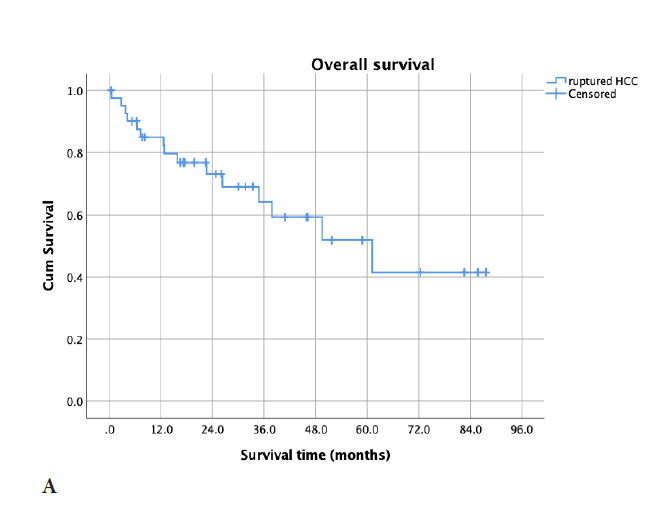Factors Predicting Survival in Ruptured Hepatocellular Carcinoma Treated with Surgical Resection
DOI:
https://doi.org/10.33192/Smj.2022.6Keywords:
Ruptured hepatocellular carcinoma, surgical resection, risk factors, survivalAbstract
Background: Today, ruptured hepatocellular carcinoma (HCC) is a less frequently encountered problem globally due to availability of cancer surveillance protocols for the high-risk population. However, in Thailand, a number of patients do not enroll in screening programs, leading to high rates of ruptured complications. In fit-for-surgery and clinically stable patients, hepatectomy means long-term survival. This study aimed to identify predictive factors of survival in resected patients.
Methods: A retrospective review of patients with ruptured HCC who underwent liver resection between January 2013 and December 2019 at Siriraj Hospital was performed. The clinical data and outcomes of patients were analyzed.
Results: A total of forty-five patients with ruptured HCC underwent resection or 9.8% (45/460) of all operable HCC cases. There were 6 patients (14.3%) who suffered from postoperative liver failure and one patient (2.4%) died within 30 days. Overall survival (OS) and recurrence-free survival were 90%, 64%, 52% and 42.5%, 24%, 16% at 1, 3, and 5 years, respectively. The factors affecting OS were tumor size > 10 cm, vascular invasion, and positive resection margin.
Conclusion: Ruptured HCC is treatable disease and surgical resection plays a major role in good outcomes in patients.
References
Bray F, Ferlay J, Soerjomataram I, Siegel RL, Torre LA, Jemal A. Global cancer statistics 2018: GLOBOCAN estimates of incidence and mortality worldwide for 36 cancers in 185 countries. CA Cancer J Clin 2018;68:394-424.
Sahu SK, Chawla YK, Dhiman RK, Singh V, Duseja A, Taneja S, et al. Rupture of Hepatocellular Carcinoma: A Review of Literature. J Clin Exp Hepatol 2019;9:245-56.
Chearanai O, Plengvanit U, Asavanich C, Damrongsak D, Sindhvananda K, Boonyapisit S. Spontaneous rupture of primary hepatoma: report of 63 cases with particular reference to the pathogenesis and rationale treatment by hepatic artery ligation. Cancer 1983;51:1532-6.
Zhang W, Zhang ZW, Zhang BX, Huang ZY, Zhang WG, Liang HF, et al. Outcomes and Prognostic Factors of Spontaneously Ruptured Hepatocellular Carcinoma. J Gastrointest Surg 2019;23:1788-800.
Mahawithitwong P, Charoensilavath D, Sirivatanauksorn Y, Limsrichamrern S, Kositamongkol P, Tovikkai C, et al. Predictivive Factors of Mortality in Ruptured Hepatocellular Carcinoma. J Med Assoc Thai 2020;103:75-81.
Sada H, Ohira M, Kobayashi T, Tashiro H, Chayama K, Ohdan H. An Analysis of Surgical Treatment for the Spontaneous Rupture of Hepatocellular Carcinoma. Dig Surg 2016;33:43-50.
Yeh CN, Lee WC, Jeng LB, Chen MF, Yu MC. Spontaneous tumour rupture and prognosis in patients with hepatocellular carcinoma. Br J Surg. 2002;89(9):1125-9.
Joliat GR, Labgaa I, Uldry E, Demartines N, Halkic N. Recurrence rate and overall survival of operated ruptured hepatocellular carcinomas. Eur J Gastroenterol Hepatol 2018;30:792-6.
Mizuno S, Yamagiwa K, Ogawa T, Tabata M, Yokoi H, Isaji S, et al. Are the results of surgical treatment of hepatocellular carcinoma poor if the tumor has spontaneously ruptured? Scand J Gastroenterol 2004;39:567-70.
Liu CL, Fan ST, Lo CM, Tso WK, Poon RT, Lam CM, et al. Management of spontaneous rupture of hepatocellular carcinoma: single-center experience. J Clin Oncol 2001;19:3725-32.
Chen CY, Lin XZ, Shin JS, Lin CY, Leow TC, Chen CY, et al. Spontaneous rupture of hepatocellular carcinoma. A review of 141 Taiwanese cases and comparison with nonrupture cases. J Clin Gastroenterol 1995;21:238-42.
Aoki T, Kokudo N, Matsuyama Y, Izumi N, Ichida T, Kudo M, et al. Prognostic impact of spontaneous tumor rupture in patients with hepatocellular carcinoma: an analysis of 1160 cases from a nationwide survey. Ann Surg 2014;259:532-42.
Lee HS, Choi GH, Choi JS, Han KH, Ahn SH, Kim DY, et al. Staged partial hepatectomy versus transarterial chemoembolization for the treatment of spontaneous hepatocellular carcinoma rupture: a multicenter analysis in Korea. Ann Surg Treat Res 2019;96:275-82.
Ren A, Luo S, Ji L, Yi X, Liang J, Wang J, et al. Peritoneal metastasis after emergency hepatectomy and delayed hepatectomy for spontaneous rupture of hepatocellular carcinoma. Asian J Surg 2019;42:464-9.
Zhou SJ, Zhang EL, Liang BY, Zhang ZY, Chen XP, Huang ZY. Distilled Water Lavage During Surgery Improves Long-Term Outcomes of Patients with Ruptured Hepatocellular Carcinoma. J Gastrointest Surg 2015;19:1262-70.
Yang T, Sun YF, Zhang J, Lau WY, Lai EC, Lu JH, et al. Partial hepatectomy for ruptured hepatocellular carcinoma. Br J Surg 2013;100:1071-9.
Uchiyama H, Minagawa R, Itoh S, Kajiyama K, Harimoto N, Ikegami T, et al. Favorable Outcomes of Hepatectomy for Ruptured Hepatocellular Carcinoma: Retrospective Analysis of Primary R0-Hepatectomized Patients. Anticancer Res 2016;36:379-85.
Fung AKY, Chong CCN, Lee KF, Wong J, Cheung YS, Fong AKW, et al. Outcomes of emergency and interval hepatectomy for ruptured resectable hepatocellular carcinoma: a single tertiary referral centre experience. Hepatoma Research 2017;3:196-204.
Kwak MS, Lee JH, Yoon JH, Yu SJ, Cho EJ, Jang ES, et al. Risk factors, clinical features, and prognosis of the hepatocellular carcinoma with peritoneal metastasis. Dig Dis Sci 2012;57:813-9.
Kow AW, Kwon CH, Song S, Shin M, Kim JM, Joh JW. Risk factors of peritoneal recurrence and outcome of resected peritoneal recurrence after liver resection in hepatocellular carcinoma: review of 1222 cases of hepatectomy in a tertiary institution. Ann Surg Oncol 2012;19:2246-55.

Published
How to Cite
Issue
Section
License
Authors who publish with this journal agree to the following conditions:
Copyright Transfer
In submitting a manuscript, the authors acknowledge that the work will become the copyrighted property of Siriraj Medical Journal upon publication.
License
Articles are licensed under a Creative Commons Attribution-NonCommercial-NoDerivatives 4.0 International License (CC BY-NC-ND 4.0). This license allows for the sharing of the work for non-commercial purposes with proper attribution to the authors and the journal. However, it does not permit modifications or the creation of derivative works.
Sharing and Access
Authors are encouraged to share their article on their personal or institutional websites and through other non-commercial platforms. Doing so can increase readership and citations.














